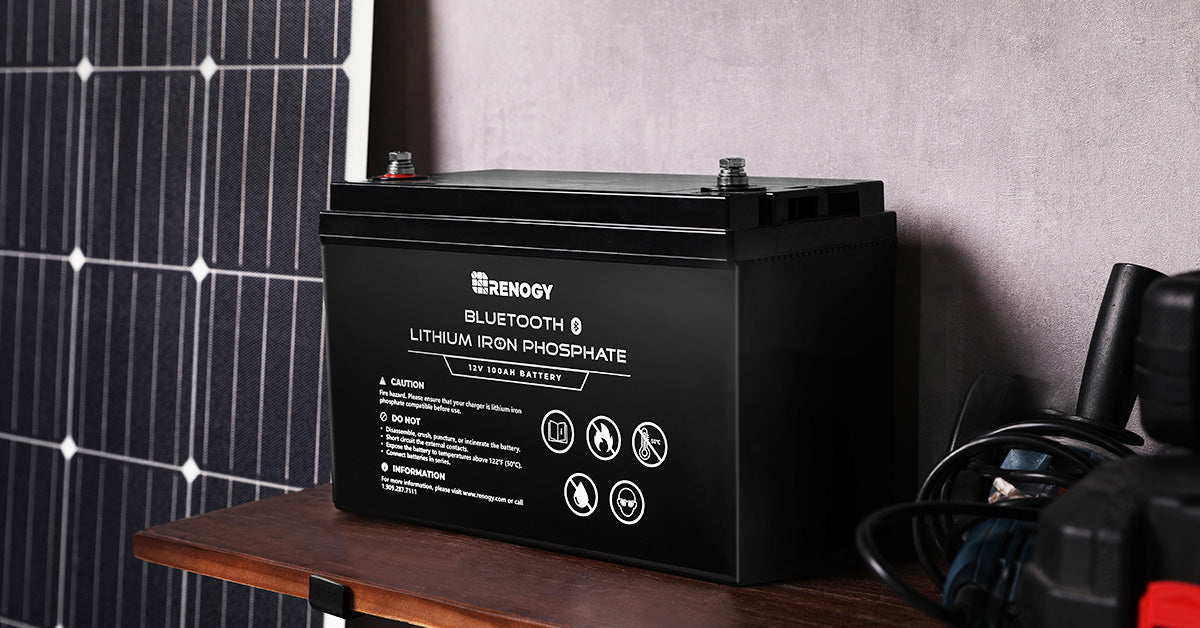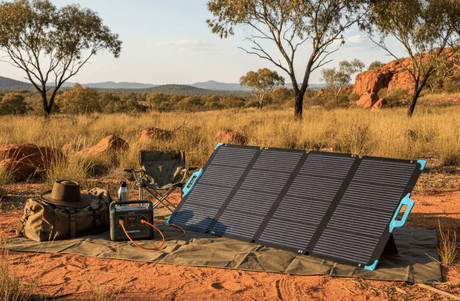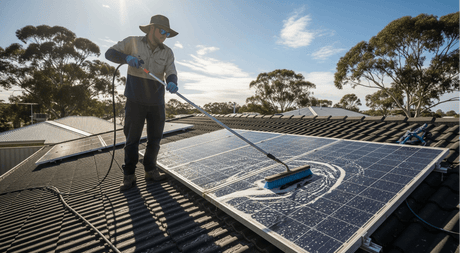Solar batteries play an increasingly significant role in the installation of solar power systems. They offer important benefits, such as energy independence and emergency backup power. However, when it comes to buying a solar battery, it is often hard to make decisions for the inexperienced.
What is a Solar Battery?
Solar panels perform at their best in the middle of the day. Unfortunately, sometimes we are not able to use that energy because we don’t have the ability to store it.

Solar batteries can store solar energy that is created during the daytime, so you can use it later in the evening when the sun goes down. This allows your home appliances to continue to operate with clean, renewable solar energy, even when your solar panels stop generating electricity.
Solar home energy storage also allows you to rely less on the grid. The major advantages of the “ off grid solar” system are lower electricity bills and access to a reliable backup power supply if the power grid goes down. So how do you choose the best batteries for use with your solar panels?
What to consider when purchasing a solar battery
There are four key features to consider when buying a solar battery:
- Assessment of power and capacity
- Discharge depth (DoD)
- Round-trip efficiency
- Warranty

Let’s inspect each of these points and what they mean.
Assessment of power and capacity
The first thing you need to consider when buying a solar battery is the capacity and power rating. The capacity assessment shows how much electricity a solar batter contains, which is often measured by kilowatt-hours (kWh). This represents the actual amount of electricity you have stored in the battery.
Capacity assessment alone is not very useful. You also need to consider battery power. A power rating indicates how much electricity a solar battery can transfer to power your home in one interval. This will tell you clearly how many appliances and devices can be powered with one solar battery.
High-capacity, low-power solar batteries are useful as emergency backup power because they can power several important devices, such as refrigerators or washing machines, for extended periods of time.
A low-capacity, high-power battery will power the entire house, but only for a few hours because less electricity is stored in the battery.
Discharge depth (DoD)
The discharge depth (DoD) of a solar battery is the percentage of battery discharge in relation to the total battery capacity. Most solar batteries will have a list of specific DoDs to maintain battery health.
Higher DoD ratings allow you to use more energy stored in the solar battery before you have to charge it. For example, let’s say you have a solar battery with a capacity of 10 kWh and a recommended DoD of 60%. This means you should not use over 6 kWh of electricity before charging the battery. Using more than 6 kWh could damage the battery.
Round-trip efficiency
Round trip efficiency refers to the ratio of the energy you can use from the solar cell to the energy you need to store energy. So here’s an example: when an amount of electricity of 10kWh was produced and sent to your battery, only 8kWh of that electricity is successfully reserved. This means that the battery operating system needs 2 kWh of electricity to store and discharge electricity. Here, the battery round-trip efficiency rating is 80%.
High-efficiency batteries prove more cost-effective because a higher proportion of electricity is available compared to that of a lower-efficiency battery.
Warranty
The warranty indicates the life expectancy of a solar battery. Most household solar batteries can last more than 10 years on average with regular use.
Solar battery manufacturers usually measure warranties in terms of ‘cycles’. The cycle occurs when the battery is fully charged and then discharged to the recommended DoDs. The more cycles a battery experiences, the weaker its ability to hold a charge.
How you use a solar battery affects how many cycles will remain. The solar battery warranty guarantees that the battery will operate at a certain capacity not only after a certain number of cycles or lifetimes, but also after a certain number of years.
Types of solar batteries
There are two major types of batteries for storing solar energy: lead-acid batteries and lithium iron phosphate batteries (LiFeaPO4).
Lead-acid batteries have been used in solar energy storage solutions for a long time. Their technology has been around for a while, which makes them cost-effective. However, their drawbacks are; required maintenance on a regular basis, and shorter service life. In comparison to their counterpart, LiFePO4 batteries have the edge with extended longevity and high efficiency, but that also means they cost more.

1. Flooded lead acid (FLA)
FLA batteries have plates that are immersed in water. They must be regularly inspected and topped off every 1-3 months in order to function properly.
Interruptions in maintenance may shorten battery life and void the warranty. FLA batteries must also be installed in a separate room to allow gases to be expelled from the batteries.
2. Sealed lead acid (SLA)
SLA batteries come in two forms, AGM (Absorbent Glass Mat) and Gel, which have a myriad of similar attributes. They require little maintenance and do not evaporate.
The key difference between AGM compared and Gel batteries is that Gel batteries have a lower charge rate. Gel batteries generally cannot withstand high charging capacities, so they require longer charge times.
3. Lithium iron phosphate (LPF)
The best chemistry of lithium batteries for solar use is lithium iron phosphate, abbreviated to LFP or LiFePO4 batteries. This advanced technology allows for a longer lasting performance with little to no physical maintenance. Better yet, they can be utilized for deep cycle applications.
The LiFePO4 battery costs more initially, but the added efficiency means you will likely consume less per kilowatt-hour during the battery life.
It is estimated that the service life of one lithium battery can span about 10 years, almost equivalent to the sum of three lead batteries. You can also do the math by using the guaranteed service life offered by manufacturers.
However, the performance and service life can be affected by a myriad of factors such as charging temperature, charge source, discharge depth, overall system design, and daily maintenance.
5 critical differences between lead-acid and lithium batteries
#1. Life cycle
When you discharge the battery (use it to power a device) and then charge it, this is called a single charge cycle. We measure battery life not in relation to years, but how many cycles they can do before performance begins to deteriorate.
A sealed battery made of lead GEL or AGM battery in a vacation cabin can go through 100 cycles in 4 years, while the same battery could go through 300+ cycles in one year in a permanent residence (house).
#2. Depth of discharge (DoD)
Discharge depth refers to the capacity to be discharged from a 100 percent charged battery. For example, if only 80 percent of the battery capacity can be used, then the discharge depth would be measured as 80 percent. Usually, a standard discharge depth would be recommended by manufacturers, showing how much capacity can be used before a new charge. No batteries would discharge completely when being used.
GEL / AGM batteries should only run up to 50% of the discharge depth. Over that point, you risk negatively affecting their lifespan.
In contrast, lithium-ion batteries allow for deeper discharge of up to 80% or more. This also represents a much-enhanced efficiency capacity.
#3. Efficiency
Lithium batteries are more efficient. In other words, you will have more solar energy for use or even for storage.
As an example, a lead-acid battery with 80% to 85% efficiency means that if 1,000 W of sunlight coming into the batteries, only 800-850 W is available to you after the charging and discharging process.
Lithium batteries are over 95% more efficient. In the same example, you will have over 950 W of power available.
Higher efficiency means batteries charge faster. In terms of the configuration of the solar PV system, high efficiency allows for fewer solar panels, lower battery capacity and a smaller solar backup generator.
#4. Charging range
With higher efficiency, lithium batteries can be charged faster. They can work with a larger amperage than the charger, so they can be charged much faster than a lead-acid battery.
In contrast, lead-acid batteries cannot work with a larger amount of charge current, which can lead to an overheating problem. This also means you cannot charge them too fast. In addition, the charging rate becomes significantly slower as you approach full capacity.
#5. Density
Lifepo4 Batteries boast a higher storage capacity for solar energy than lead batteries. This result is in relation to the condition of energy density: the higher the energy density, the better the storage capacity. Lithium batteries provide a much higher energy density than lead batteries.
Choose the best batteries for solar in Australia in 2022
Considering the amazing lifespan, DoD, maintenance and most importantly, efficiency, lithium iron batteries are the best fit for solar power storage. Though the upfront cost can be a little intimidating, their performance can pay it back in several years and save you as many hassles that other types of batteries can entail as possible. We have every reason to believe lithium batteries are the best for off-grid solar in Australia based on current battery technologies and economic considerations. Then where can you find them? Check them out on the Renogy store now.
Related articles:
Solar Battery Price: Is It Worth The Cost?
Smart Lithium Iron Phosphate Batteries for Solar: What Are the Benefits?







![What Is a DC to DC Battery Charger [Comprehensive Guide]](http://au.renogy.com/cdn/shop/articles/IMG_3829_bd86de74-31d6-49fd-b9d5-265bb723091d.jpg?v=1757582605&width=460)


